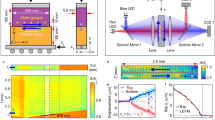Abstract
Results from a study of stick-slip particle motion at the interface between two stressed foam rubber blocks indicate that normal vibrations and interface separation are an important part of the stick-slip process in foam rubber. The dimension of the dynamic slip pulse is small compared to the dimension of the model (approximately 10 cm vs. 200 cm) consistent with the abrupt-locking slip pulse model ofBrune (1970, 1976), andHeaton (1990). A comparison of frictional heat generation between stable-sliding and stick-slip foam rubber models indicates a linear relation between the temperature increase on the fault surface (for a given distance of slip) and the driving shear force for the stable-sliding model, while for the stick-slip model there is essentially no variation in frictional heat generation with an increase in shear stress. We performed experiments to investigate the ratio of normal motion to shear motion at different levels of normal stress in the stick-slip foam rubber model. Preliminary result indicate that the normal component of the particle motion increases more rapidly with increasing normal stress than the shear component. The phenomenon of interface separation and normal vibrations may thus explain some of the most frustrating problems in earthquake mechanics, e.g., the heat flow paradox, the long-term weakness of major active faults, and anomalousP-wave radiation.
Similar content being viewed by others
References
Anooshehpoor, R., andBrune, J. N. (1992),Normal Vibration, Fault Separation, and Heat Generation During Stick-slip Events in Foam Rubber, Seismol. Res. Letts.63, (1), 75.
Blandford, R. R. (1975),A Source Theory for Complex Earthquakes, Bull. Seismol. Soc. Am.65, 1385–1405.
Brown, S. R. (1993),Frictional Heating on Faults: Stable Sliding Versus Stick Slip, submitted to Nature.
Brown, S. R., Olsson, W. A., andBrune, J. N. (1991),Experimental Observation of Interface Separation Waves During Stick Slip, EOS72 (44), 326.
Brune, J. N., Henyey, T. L., andRoy, R. F. (1969),Heat Flow, Stress, and Rate of Slip along the San Andreas Fault, California, J. Geophys. Res.74, 3821–3827.
Brune, J. N. (1970),Tectonic Stress and the Spectra of Seismic Shear Waves from Earthquakes, J. Geophys. Res.75, 4997–5009.
Brune, J. N.,The physics of earthquake strong motion. InSeismic Risk and Engineering (eds. Lomnitz, C., and Rosenblueth, E.) (Elsevier Sci. Publ. Co., New York, NY 1976) pp. 141–177.
Brune, J. N., Brown, S., andJohnson, P. A. (1993),Rupture Mechanism and Interface Separation in Foam Rubber Models of Earthquakes: A Possible Solution to the Heat Flow Paradox and the Paradox of Large Overthrusts, Tectonophys.218, 59–67.
Byerlee, J. D. (1990),Friction, Overpressure and Fault Normal Compression, J. Geophys Res. Letts17, 2109–2112.
Byerlee, J. D. (1992),The Change in Orientation of Subsidiary Shears Near Faults Containing High Pore Fluid Pressure, Tectonophys.211, 295–303.
Castro, R. R., Anderson, J. G., andBrune, J. N. (1991),Origin of High P/S Spectral Ratios from the Guerrero Accelerograph Array, Bull. Seismol. Soc. Am.81, (6), 2268–2288.
Comninou, M., andDundurs, J. (1977),Elastic Interface Waves Involving Separation, Transaction of the ASME, J. Appl. Mech., 222–226.
Comninou, M., andDundurs, J. (1978a),Can Two Solids Slide Without Slipping?, J. Sol. Struct.14, 251–260.
Comninou, M., andDundurs, J. (1978b),Elastic Interface Waves and Sliding Between Two Solids, J. Appl. Mech.45, 325–355.
Coyle, B. J., andZoback, M. D. (1988),In Situ Permeability and Fluid Pressure Measurements at ∼2 km Depth in The Cajon Pass Research Well, Geophy. Res. Lett.15 (9), 1029–1032.
Dahlen, F. A. (1974),On the Ratio of P-wave to S-wave Corner Frequencies for Shallow Earthquake Sources, Bull. Seismol. Soc. Am.64, 1159–1180.
Dieterich, J. H.,A model for the nucleation of earthquake slip. InFifth Maurice Ewing Symposium on Earthquake Source Mechanics, May 20–23, 1985 (eds. Das, S., Boatwright, J., and Scholz, C. H.) (Herriman, NY 1986) pp. 37–47.
Freund, L. B. (1978),Discussion, ASME, J. Appl. Mech.45, 226–228.
Haskell, N. (1964),Total Energy and Energy Spectral Density of Elastic Wave Radiation from Propagating Fault, Bull. Seismol. Soc., Am.54, 1811–1841.
Heaton, T. H. (1990),Evidence for, and Implications of Self-healing Pulse of Slip in Earthquake Rupture, Phys. Earth. Planet. Sci.16, 1–20.
Hubbert, M. K., andRubey, W. W. (1959),Role of Fluid Pressure in Mechanics of Overthrust Faulting—1. Mechanics of Fluid-filled Porous Solids and its Application to Overthrust Faulting, Geol. Soc. Am. Bull.70, 115–166.
Lachenbruch, A. H. (1980),Frictional Heating, Fluid Pressure, and the Resistance to Fault Motion, J. Geophys. Res.85, 6079–6112.
Lockner, D. A., Okubo, P. G., andDieterich, J. H. (1982),Containment of Stick-slip Failures on a Simulated Fault by Pore Fluid Injection, Geophys. Res. Lett.9, 801–804.
Lockner, D. A., andOkubo, P. G. (1983),Measurements of Frictional Heating in Granite, J. Geophys. Res.88, 4313–4320.
Molnar, P., Tucker, B. E., andBrune, J. N. (1973),Corner Frequencies of P and S Waves and Models of Earthquake Sources, Bull. Seismol. Soc. Am.63, 2091–2104.
Mora, P., andPlace, D. (1994),Simulation of the Frictional Stick-slip Instability, accepted for publication in part II of the special issue of PAGEOPH on Faulting, Friction and Earthquake Mechanics.
Rice, J. R. (1992),Fault stress states, pore pressure distributions, and the weakness of San Andreas Fault. InEarthquake Mechanics and Transport Properties of Rocks (eds. Evans, B., and Wong, T. F.) (London, Academic Press 1992) pp. 475–503.
Schallamach, A. (1971),How Does Rubber Slide? Wear17, 301–312.
Vernon, F., Brune, J. N., andFletcher, J. (1989),P/S Spectral Ratios for the Anza Array: Evidence for Normal Motions During Fault Rupture, Trans. Am. Geophys. Union70, 1226.
Zoback, M. D., Zoback, M. L., Mount, V. S., Suppe, J., Eaton, J. P., Healy, M. D., Oppenheimer, D., Reasenberg, P., Jones, L., Raleigh, C. B., Wong, I. G., Scotti, O., andWentworth, C. (1987),New Evidence on the State of Stress of San Andreas Fault System, Science238, 1105–1111.
Author information
Authors and Affiliations
Rights and permissions
About this article
Cite this article
Anooshehpoor, A., Brune, J.N. Frictional heat generation and seismic radiation in a foam rubber model of earthquakes. PAGEOPH 142, 735–747 (1994). https://doi.org/10.1007/BF00876062
Received:
Accepted:
Issue Date:
DOI: https://doi.org/10.1007/BF00876062



